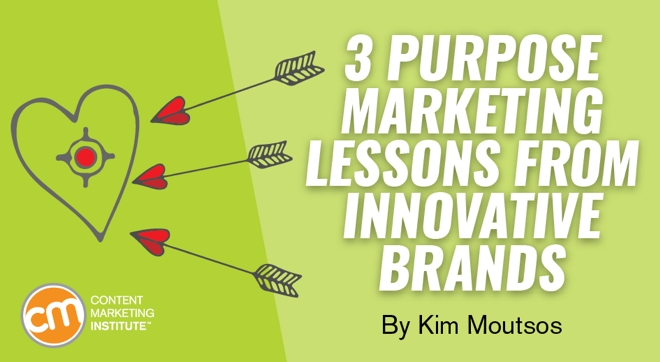What is purpose-driven marketing? Some people use the terms purpose-driven marketing and cause-related marketing interchangeably. The past 10 years have seen a spike in the number of companies willing to describe their purpose not just in terms of making their customers’ lives easier or better, but also in making the world better. The 2018 Cone/Porter Novelli Purpose Study found that “78% of Americans believe companies must do more than just make money; they must positively impact society as well.” Among the other findings: Two-thirds of consumers surveyed say they would switch to a product from a purpose-driven company, and 68% say they would feel more willing to share content with their social networks from purpose-driven companies than traditional companies. What to learn from innovative purpose-driven brands Patagonia’s obviously a leader in purpose-driven marketing and on Fast Company’s social-good segment. Make shared values visible in your marketing and your service Instead of setting fees for some of its financial services, up-start Aspiration made a splash by allowing customers to decide their fee. The idea is to help Aspiration customers make spending decisions in line with their personal ethics or beliefs. In this way, the service continually reinforces the shared goal of the company and its customers: to “make money and make a difference.” Takeaway: Look for opportunities to remind customers of the values you share every time they engage with your brand or use your services. In the past two years, Ripple founders created Our Progress, Your Impact, which summarizes the carbon savings, water reduction, and sugar avoidance the Ripple choice has made in the course of a year. Not every company can or should go as all-in as Patagonia.

Quick: Think of some purpose-driven brands. I’ll wait.
I’ll bet a bunch of you thought of Patagonia.
The outdoor clothing and gear seller started by rock climber and adventurer Yvon Chouinard in 1973 weaves environmental activism into the very fabric – and even the bylaws – of the company.
You probably read about Patagonia’s “Don’t Buy This Jacket” ad that ran in The New York Times on Black Friday 2011. It asked people to focus on buying less – on the biggest shopping day of the year.

But that’s old news. Why did Fast Company put it 6th on its list of the world’s most innovative companies in 2018 and move it to the top spot for the social-good sector?
Let’s explore some of the innovative ideas that earned Patagonia its place on the lists and look at ideas from other companies that earned nods for their social-good activities. But first, some context around why these ideas resonate today.
What is purpose-driven marketing?
Some people use the terms purpose-driven marketing and cause-related marketing interchangeably. I think of purpose-driven marketing as the more encompassing term, which revolves around a company’s greater purpose (read: beyond selling products).
When CMI founder Joe Pulizzi wrote about this a decade ago, he cited marketing executive Jim Stengel’s definition, that purpose-driven marketing is “about defining what a company does – beyond making money – and how it can make its customers’ lives better.”
At the time, Joe equated that definition to content marketing. The past 10 years have seen a spike in the number of companies willing to describe their purpose not just in terms of making their customers’ lives easier or better, but also in making the world better.
Cause-related marketing typically describes a company’s support for a cause, often within a defined campaign that might involve a nonprofit partner.
I found this graphic, from a presentation on cause marketing by Lincoln Electric’s Craig Coffey, useful for understanding the range of corporate social responsibility and involvement. Cause-related charitable giving shows up at one end of the continuum and purpose ingrained into company culture resides at the other.

Consumer expectations and brand standing
Not only are companies increasingly willing to speak up for causes they support (see the brand standing trend Rohit Bhargava noted earlier this year), but consumers practically demand that they do.
The 2018 Cone/Porter Novelli Purpose Study found that “78% of Americans believe companies must do more than just make money; they must positively impact society as well.”
Among the other findings: Two-thirds of consumers surveyed say they would switch to a product from a purpose-driven company, and 68% say they would feel more willing to share content with their social networks from purpose-driven companies than traditional companies.
What to learn from innovative purpose-driven brands
Patagonia’s obviously a leader in purpose-driven marketing and on Fast Company’s social-good segment. But it’s far from the only company to study…

COMMENTS